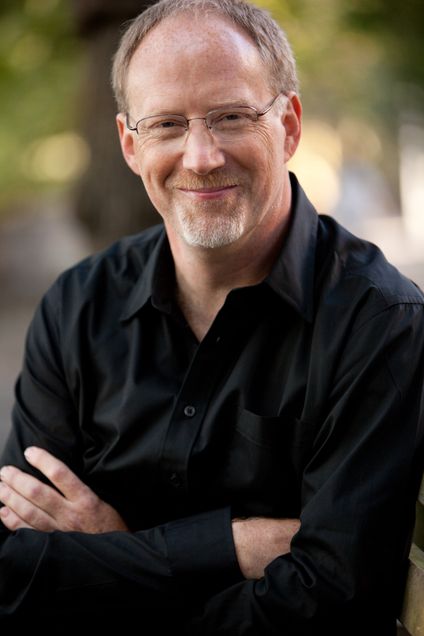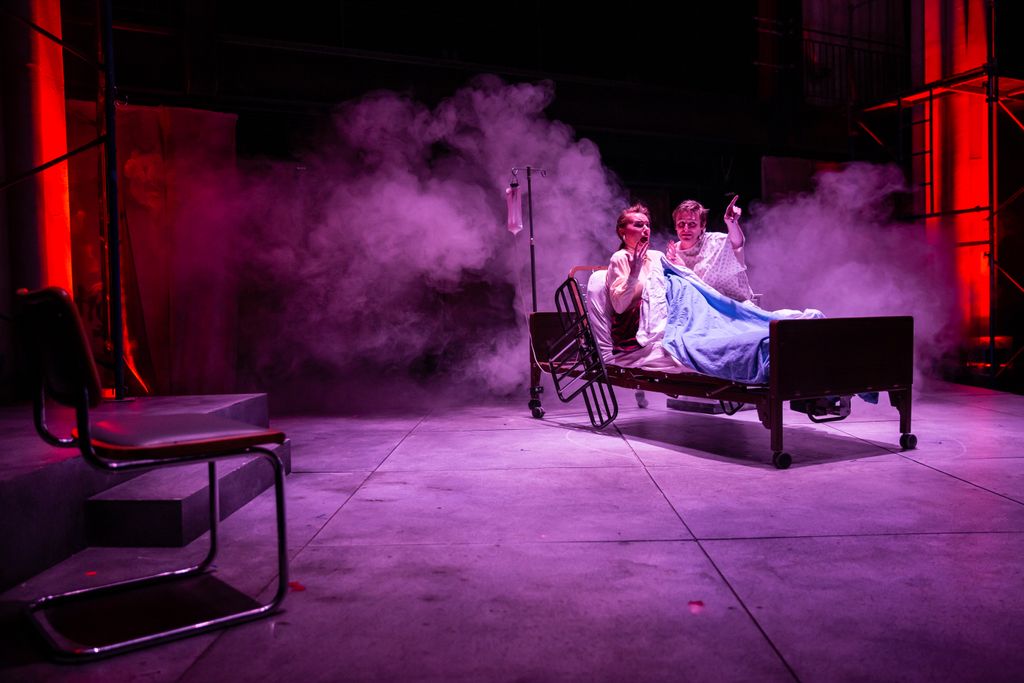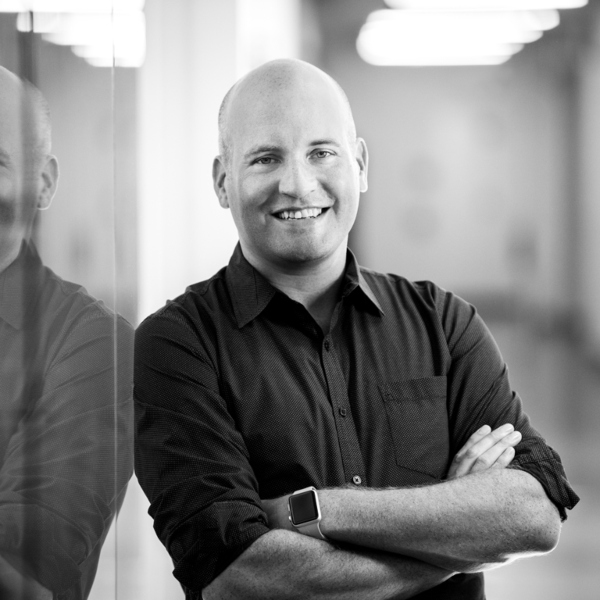Faculty Feature: Mark Stanley

Having designed more than 200 premieres for New York City Ballet’s repertory, Mark Stanley, Professor of Lighting Design at BU and NYC Ballet’s Resident Lighting Designer, is a leader in lighting design and shares his wealth of knowledge with current theatre students.
In the CFA Faculty Feature, Stanley talks about his field and what makes him excited to teach lighting design at BU, with the main reason being helping individual students find their artistic voices. He dives into the importance of lighting design and how lighting is the glue of any production, connecting the set with the costumes and guiding audience members on where to place focus.
He also shares with CFA what he looks for in applicants to the lighting design program and why a student should select this program in Boston over one offered in an institution located in New York City.
Q&A
INTERVIEW WITH MARK STANLEY
CFA: What does lighting design do?
Stanley: A lighting design is created using some basic functions and qualities of light in support of telling stories. The functions of light on stage would be, first, the obvious one of creating visibility but that doesn’t mean making everything bright. It’s selective visibility. What do we want the audience to look at? What do we want them to experience on stage in support of the storytelling? Lighting creates the mood. It’s an art form that deals in both time and space. It can be totally flexible in how it changes during a production. So, creating mood is a very important part of lighting design.
Lighting helps define the environment. The environment on stage can be abstract or real: naturalism versus some other form. The lighting supports creating the space in which the story unfolds, thereby adding context to the story. Within that, it helps in composition because as I mentioned, where does an audience look? Where does the director place the actor? How do you get the audience to go with you regarding where you want them to look? Finally, lighting is the glue of a production. It brings together all the elements into one stylistic whole. A set designer might be doing one thing and a costume designer is doing something a little different but hopefully in the same vocabulary, and lighting brings those two elements together for the performance, thereby supporting the storytelling. It does all of those things within the context of live performance.
CFA: As an audience member, should I notice the lighting?
Stanley: For years, there was the adage that good lighting goes unnoticed. That was the premise on which a lot of lighting designers operated. I like to rephrase that a little bit. I say that good lighting design should not be distracting. You notice a good performance as an audience member. You say, “I really loved the set.” Or, “those costumes were really interesting and helped the character.” You should also be aware that lighting is helping to make the experience more interesting, more exciting. In that sense, you hope somebody notices the lighting but it shouldn’t distract from the performance. It should be so integrated that it feels part of the whole.
There are a lot of subliminal things in lighting including the use of color, angle, shadow, and intensity – all qualities of light that we manipulate. If you take a show like Hamilton, the lighting is really obvious. It moves and the colors change. There’s lots of light cues. Then you take a show like To Kill a Mockingbird. The lighting in that show is stunningly beautiful but you don’t really notice it. The way the lighting designer manipulates your eye, making contrasts, and creating composition are all just as skillful as Hamilton but it’s just different.
Lighting is the glue of a production. It brings together all the elements into one stylistic whole. A set designer might be doing one thing and a costume designer is doing something a little different but hopefully in the same vocabulary, and lighting brings those two elements together for the performance, thereby supporting the storytelling.
CFA: What makes you excited about teaching in the lighting program at BU College of Fine Arts?
Stanley: I love helping individual students find their artistic voices. When they enter the program, many of them are still trying to figure out who they are as artists. That journey is very exciting for me. They go from someone who is trying to sort out what their point of view is about lighting and theater and at the end of the program, they come out – not as fully formed artists because hopefully, we’re always growing throughout our entire career – but having a better sense of who they are as artists and are ready to confidently enter the world of theater-makers. That’s exciting to me.
CFA: We’ve heard from other theatre department heads how students are not expected to graduate with their work looking a certain way. Do you agree?
Stanley: I agree with my colleagues. When I am interviewing graduate applicants, I say BU is not a cookie-cutter program. We don’t want to turn out people who design “like Boston University graduates.” I think that’s one of the hallmarks of our program. I don’t want someone to design as I do. I want them to learn from what I know and hopefully, that will help them find their individual voice. But I think one of the strong points of our program is that our graduates come out of here designing all different ways based on who they are and what their experiences are.
CFA: Have graduates found success in the field?
Stanley: Absolutely. We have a really good success rate. I was just recently talking to a graduate who, since graduation, has had a full-time lighting design career. Most of our students in some fashion or another are making a career in lighting. A lot of applicants ask, “What are your alumni doing?” I answer, first of all, they’re doing what they love. They’re doing so many different things – which is exactly what our program is designed to make possible for them. One potential student said to me, “I understand BU churns out Broadway designers.” I said, well, I don’t think so. First, we don’t churn out anybody. Second, look at our alumni. They’re working everywhere. The world is much bigger than Broadway.
CFA: What do you look for in an applicant?
Stanley: First, I look for people who are passionate about theater and about lighting. A lot of people love lighting but maybe don’t love theater as much. They need to be passionate about theater as an art form. Second, they need to be curious. I don’t want people coming in who aren’t interested in finding out something new. They shouldn’t be formula driven. So, they need to be passionate, curious, and also open-minded about what the possibilities are. They need to be willing to take criticism and try something new. I won’t dictate what they should try. I am going to encourage them to try something different from what they’ve done in the past.
My thing is – throw out everything you know and let’s try something different. If in the end, you end up doing it the way you used to do it, that’s fine, as long as you’ve tried some new things. They need to have a certain level of experience in theater and lighting design to do well in our program. It’s not a remedial program; it’s a professional training program. Still, I would give more weight to passion, curiosity, and excitement about lighting and theater than I would to skill sets.
CFA: If you can’t experiment in a grad program, where can you experiment?
Stanley: That’s the beauty of an academic experience. You can make mistakes, you can try things. There’s no professional pressure to get it exactly right the first time.
CFA: Why should a student choose BU over a program in a rural setting where the program is a major generator of theatre for a region?
Stanley: I think the advantage of Boston, BU, in particular, is first, we have a committed professional faculty. All of us are working designers. We bring that experience to the classroom and use our work and connections to help build pathways to future careers. Going to a regional hub makes you one step removed from the professional community. Second, Boston has a vibrant arts community. You have to decide what pool you want to play in regarding where you want to be professionally.
Boston is a really good stepping stone to a larger theater community. That doesn’t mean that you won’t get a good education somewhere else. There are lots of good schools out there that are not in major metropolitan hubs. But because we are in Boston and near New York, and we have a professional design faculty, we can offer a broader spectrum of experiences and connections than other schools.
Boston has a vibrant arts community. Because we are in Boston and near New York, AND we have a professional design faculty, we can offer [students] a broader spectrum of experiences and connections than other schools.
CFA: Why not attend a program in New York City?
Stanley: A program there is in the midst of the theater community and that brings some advantages. But we offer a broader, more holistic view of what theater-making is. We focus on the student as an individual. We offer a high level of mentorship. Students know we are all working in the field and sometimes they worry that we will be too busy to have time for mentoring. I spend a lot of time reassuring them that we probably put in more hours mentoring than we do in the classroom or in production. Even though we’re a professional faculty, we’re very hands-on. When you come to Boston University, you’re part of a community of people that are actively engaged in that community. The faculty is as engaged as the students.
This Series
Also in
Faculty Features
-
December 12, 2023
Faculty Feature: Daniel Parsley
-
September 6, 2023
Faculty Feature: Nancy Goeres
-
March 29, 2023
Faculty Feature: Rébecca Bourgault

Learn more about BU’s lighting design programs
BU offers an undergraduate program and a graduate program in lighting design. Check out a list of notable alums and where they are today, see the work of current students, and get a behind-the-scenes look at BU’s Light & Sound Lab, where students test their lighting setups prior to Booth Theatre’s big shows.

